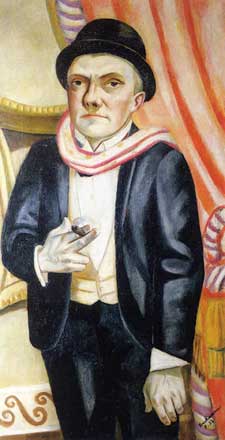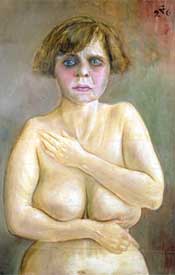
The Ring of Truth
Max Beckman, Otto Dix, Georg Grosz, and Christian Schad at The Neue Galerie
By Maureen Mullarkey
WITHOUT EXAGGERATION, MAX BECKMAN (1884-1950) WAS THE GREATEST GERMAN PAINTER of the twentieth century. He was a painter’s painter, broader in range and more complex than his contemporaries. And he sustained his productivity at the highest possible level longer than others.
 |
| Max Beckmann, Self-Portrait in Front of Red Curtain (1923). Private Collection |
“Max Beckmann: Self-Portrait with Horn,” opening today at the Neue Galerie is a splendid opportunity to view his painting and graphic work in context with the three Weimar artists who are best seen in relation to him: Otto Dix, Georg Grosz, and Christian Schad. The third floor room in which their work is grouped is not large. Nevertheless, the selection is powerful, a fitting sequel in quality, if not in size, to “Glitter and Doom,” The Metropolitan’s 2006 benchmark exhibition of German portraiture from the 1920s.
Beckmann’s self-portrait is the headliner for a summer airing of the museum’s permanent collection of German and Austrian works from the beginning of the 20th century. Austrians are showcased on the second floor. Here are the Ronald Lauder and Serge Sabarsky collections of Gustav Klimt and Egon Schiele — the museum’s mother lode — together with jewelry from the Wiener Werkstätte (Vienna Workshop).
The arrangement has a narrative of its own. Klimt, son of a gold engraver and mentor to the younger Schiele, was a patron of the Wiener Werkstätte through which the English Arts and Crafts Movement entered Austria. The workshop upheld William Morris’s rejection of any distinction between fine and applied art. Design and exquisite workmanship was the hallmark of both.
That symbiotic link between artist and craftsman extends to the rooms upstairs, not only in the Bauhaus furniture but most fruitfully in the extraordinary selection of portraits for which Beckmann provides the keynote. What ardent draughtsmen the Weimar generation were, simultaneously nuanced and vigorous. Everything on view testifies to Beckmann’s insistence that artists must be intimately and unerringly familiar with the human form. This, so that their creative exaggerations would carry the ring of truth; anatomical distortion should be deliberate in every line, never inadvertent or haphazard.
An adjoining room holds the Jugendstil founders of Die Brücke: Erich Heckel, Ernest Kirschner, Schmitt-Rottluff; also, Emile Nolde and Oskar Kokoschka, and Max Pechstein. The originators of Der Blaue Reiter are represented: Gabriel Münter, Vasily Kandinsky, August Macke, and Franz Marc (both killed in W.W.I). Bauhaus artists Oscar Schlemmer, Paul Klee, Moholy-Nagy, Oscar Feininger surround furniture by Marcel Breuer and Ludwig Mies Van Der Rohe.
Every exhibition, especially one as broad as this, invites us to make choices. For all the loveliness on view in the permanent collection (Marc’s watercolor “The First Animals” (1913) is only one small glory) we are left asking ourselves what still resonates beyond delectation? Which artists offer some glimpse, however oblique, into what is at stake in our civilization and in our own time? In terms of the art chosen for display and from the perspective of our moment, the Weimar artists, in their engagement with the pained condition of man, emerge more compelling than their expressionist cousins.
German Expressionism, seed bed for Abstract Expression, arose within Kaiser society, prior to the First World War. Beckmann, Dix, Grosz, and Schad were touched by expressionist traits but not aligned with any expressionist group. They went their own way from the start.
The qualities that best characterize each of them entered their work after the Great War. Their worldview and their art derived, in varying ways, from their war time experience. (Schad atoned for his avoidance of it by abandoning Dada to become the Neue Sachlichheit’s recording angel of postwar dissolution.) All four were immersed in the radically altered complexion of postwar society. History shrugs and man bleeds. Or, as Schad told it, dissipates.
Enigmatic and melancholy, “Self-Portrait with Horn” (1938) was painted in exile after Beckmann fled Nazi Germany. Labeled “degenerate” and fired from the Städelsches Kunstinstitut, Frankfurt, he took refuge in Amsterdam with his sister-in-law. No longer marketable as a painter or a teacher, he saw his art methodically removed from German museums; by 1937 close to 600 works had been confiscated. A non-Jew, Beckmann was able to keep working despite German invasion of Holland.
His oeuvre is replete with images of masquerade. “Self-Portrait in Front of a Red Curtain” (1923) places him, nattily dressed, against a theater curtain. With his wartime breakdown behind him, Beckmann depicts himself returning to genteel pursuits. Exquisitely rendered, it was a brief pose. His graphic and spatial genius is evident in the 1919 portfolio of lithographs “Hell” (1919), a response to the corruption and violence of postwar Berlin.
 |
| Otto Dix, Semi-Nude (1926). Private Collection |
“Semi-Nude” (1926) is one of Dix’s unsettling variations on the effect of postwar deprivation on the socially marginal, particularly women of the red light district. Another beautifully rendered but haunting portrait presents a blowzy hermaphroditic figure; a powdered male head sets on a shambling female form. Misery can be painted over with lipstick and cosmetics, but it asserts itself bodily. Dix’s nudes, like his war cripples, embody their own Gethsemane.
Grosz, the indignant Communist dandy, rises to Northern Renaissance heights in his luminous panel “Portrait of Johann Edwin Wolfensberger” (1929), a Zürich lithographer. Schad’s “Two Girls” (1928), at once elegant and corrosive, features two women, half undressed, masturbating mechanically in the same bed but without seeming to notice each other. One sports a red rose, a mocking symbol of passion where passion has fled the scene.
Wilhelm Lehmbruck’s pensive, fragmented self-portrait, cast in stone the year before he committed suicide, broods over the ensemble.
A welter of influences informed the art of the Deutsches Reich, from 1919 to 1933. No general museum compilation can sift through the turbulence of the years under review to provide entry into how such a rich, refined artistic milieu could have ended in a gutter regime. The unintended consequence of this exhibition is a heightened wakefulness to the reality that culture is much more than the production of art.




“Max Beckmann: Self-Portrait with Horn” at the Neue Galerie (1048 Fifth Avenue at 86th St., 212-628-6200).
This review appeared first in The New York Sun, July 24, 2008.
Copyright 2008, Maureen Mullarkey







